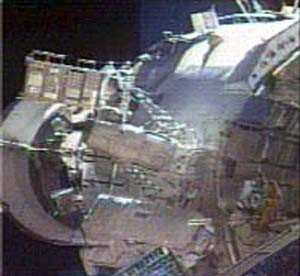Goo Gawked, Antenna Installed
 Whistling, humming and outright
singing rang through the speakers at ISS Mission Control in
Kazakhstan earlier this week as the International Space Station was
left vacant for a time. Word now is that NASA Mission Commander
Leroy Chao and Russian Cosmonaut Salizhan Sharipov successfully
complete all objectives Wednesday as they roamed the station's
exterior for more than five hours.
Whistling, humming and outright
singing rang through the speakers at ISS Mission Control in
Kazakhstan earlier this week as the International Space Station was
left vacant for a time. Word now is that NASA Mission Commander
Leroy Chao and Russian Cosmonaut Salizhan Sharipov successfully
complete all objectives Wednesday as they roamed the station's
exterior for more than five hours.
Clad in Russian Orlan spacesuits, Expedition 10 Commander and
NASA Science Officer Leroy Chao and Flight Engineer Salizhan
Sharipov left the Pirs Docking Compartment airlock at 0143 CST and
quickly set up tools and tethers for their excursion. With no one
left inside, Station systems were either deactivated or put in
autonomous operation for the duration of the spacewalk. Hatches
were also closed between the US and Russian segments of the complex
in the unlikely event the crew would not have been able to return
to the outpost.
The first order of business was the installation of a Universal
Work Platform at the forward end of the large conical section of
Zvezda. Atop the platform they mounted a German commercial
experiment called Rokviss (Robotics Component Verification on
ISS).
The Rokviss consists of a small double-jointed manipulator arm,
an illumination system and a power supply. An antenna for the
robotic device to receive commands was also installed by Chao and
Sharipov along with cabling. At first the antenna did not receive
the proper power. Chao and Sharipov returned to the antenna work
site and remated two electrical connectors. Russian engineers then
reported that the Rokviss system was operating normally.
The system is designed to be commanded by operators on the
ground in Germany. It can also be operated by the crew from a
workstation inside Zvezda. Rokviss will test the ability of
lightweight robotic joints to operate in the vacuum of space for
future assembly work or satellite repair and servicing.

Chao and Sharipov moved a Japanese commercial experiment from
one bracket on the outside of Zvezda to an adjacent bracket. The
experiment, first deployed on Station by the Expedition 3 crew in
October 2001, resembles an open attaché case and is designed
to collect data on micrometeoroid impacts and the effect of the
microgravity environment on a number of materials housed on witness
plates.
Chao and Sharipov then moved to another section of Zvezda to
inspect nearby environmental system vents that are used for the
Elektron oxygen-generator, the Vozdukh carbon dioxide scrubber and
a particle contaminant purification device.
Sharipov reported that he saw both a white and brownish residue
near the Elektron and Vozdukh ports and what appeared to be an oily
substance on insulation surrounding the ports. Russian specialists
added the task to the spacewalk a few weeks ago in light of recent
technical problems with those systems, and will analyze photos
taken by Sharipov to see if any corrosion or clogging of the vent
ports may have contributed to periodic problems with those
components.
As the spacewalk drew to a close, Chao and Sharipov installed a
Russian experiment called Biorisk near the hatch to the Pirs
airlock. Biorisk consists of several canisters on a bracket that
contain microorganisms and materials that will collect data on the
effect of the space environment for ecological analysis back on
Earth.
With their work complete, Chao and Sharipov returned to Pirs and
closed the hatch at 7:11a.m. CST to complete their spacewalk. After
repressurizing Pirs, Chao and Sharipov were scheduled to return to
the Station, remove their spacesuits, reactivate the ISS systems
and open the hatches to the US segment. The crew will begin its
sleep period early this afternoon and enjoy an off-duty day on
Thursday.

It was the first spacewalk for Sharipov and Chao’s fifth.
The excursion was the 57th in support of ISS assembly and
maintenance, the 32nd staged from the ISS itself and the 14th from
Pirs. A total of 343 hours and 45 minutes of spacewalking time has
been logged in the Station’s lifetime.
Chao and Sharipov are scheduled to conduct a second spacewalk in
late March to install additional equipment for the maiden arrival
of the European Space Agency’s “Jules Verne”
Automated Transfer Vehicle (ATV) cargo ship. The unpiloted cargo
carrier is targeted for launch late this year.
 ANN's Daily Aero-Term (04.20.24): Light Gun
ANN's Daily Aero-Term (04.20.24): Light Gun Aero-News: Quote of the Day (04.20.24)
Aero-News: Quote of the Day (04.20.24) ANN's Daily Aero-Linx (04.21.24)
ANN's Daily Aero-Linx (04.21.24) Aero-News: Quote of the Day (04.21.24)
Aero-News: Quote of the Day (04.21.24) ANN's Daily Aero-Term (04.21.24): Aircraft Conflict
ANN's Daily Aero-Term (04.21.24): Aircraft Conflict





